 Dark Ages Re-Creation Company
Dark Ages Re-Creation Company

This day of beadmaking was focused on
The Mark3 furnace retained the base plate size of the Ribe oval (30x60cm), but had several modifications:
As with the Mark2 we had people making beads using standard lampworking techniques. In this case we made them in the working ports, and in the chimneys. This photo is a bead being worked in the low chimney. Working within the chimney was quite possible but if the working port was not well sealed the heat rising from it made the dynamic of using the chimney difficult.
New in this melt was the use of tesserae. These are small pieces of glass used in the creation of mosaics. They are found on a number of sites in the viking era and are believed to be the source of glass used in the manufacture of beads.
To simplify the experiments by removing some variables the tesserae procured were broken pieces of fusing glass with a matched CoE of 92. By keeping the lampworking glass (CoE 104) separated from the tesserae (CoE 92) we hoped to reduce the issues around annealing the glass and CoE related breakage. When working with glass it is important to note that it expands when heated and contracts as it is cooled. If you make a bead with two pieces of glass with different CoE's then as the bead cools the pieces will pull apart and break the bead. While it is unlikely the norse had the luxury of matched CoE glass it should be possible to overcome this problem with annealing (slowly cooling the beads). Using a matched CoE glass simply sidesteps a difficult and frustrating problem until the basic skills have been mastered. We lose enough beads to breakage now due to other issues we don't need to make it worse with a known problem!
Working with tesserae adds a level of complexity to making the beads. The tesserae are odd shapes which means that unlike the stringers & rods, it is difficult to evenly apply the glass to the mandrel. There is also the difficulty of determining how to heat the tesserae so that it can be wound on. We used a number of methods with varying levels of success. Unfortunately in attempting to develop a new skill it is difficult to know if early problems are because the technique is not workable, or if it is just not yet mastered.
We used the following techniques:
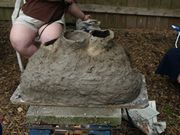 |
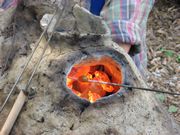 |
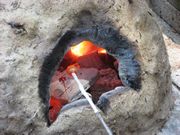 |
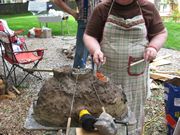 |
| Mark III | Chimney work | Bead from tesserae | Tesserae in tongs |
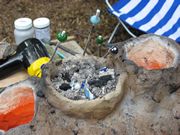 |
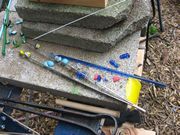 |
||
| Annealing | Materials |
Moving the bead from the mandrel through the annealing process is another area of the bead making process that produced unexpected difficulties. In one photo are four beads on mandrels, a couple of broken beads in the ash, and an unbroken (white) bead in the ash. Removing the bead from the mandrel has produced some breakage. Our current guesses as to cause are
The final image shows the materials used in beadmaking. In the lower right aboce the tweezers are two red tesserae. The tweezers themselves are useful for placing tesserae into the furnace. In this case they are modern stainless steel tools while a forged set is being made. A clear blue glass rod, and a white stringer (thinner rod) are visible in the center with green and light blue rods on the left. Additionally there are bits of glass broken from the rods, and some beads which were broken longitudinally. A spare manrel with wooden handle is visible at the bottom along with a set of forged tongs.